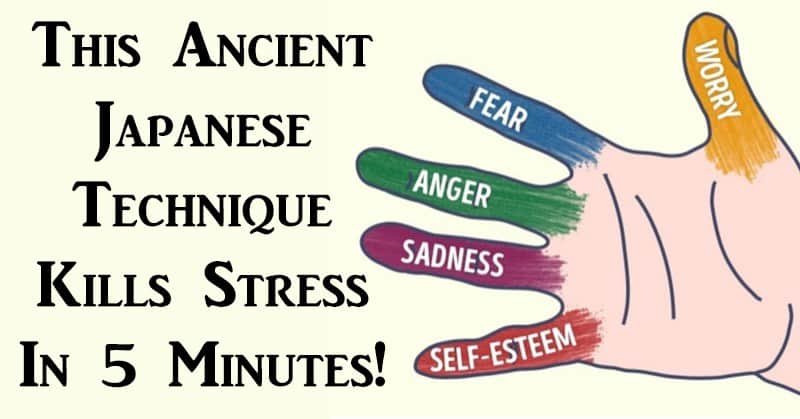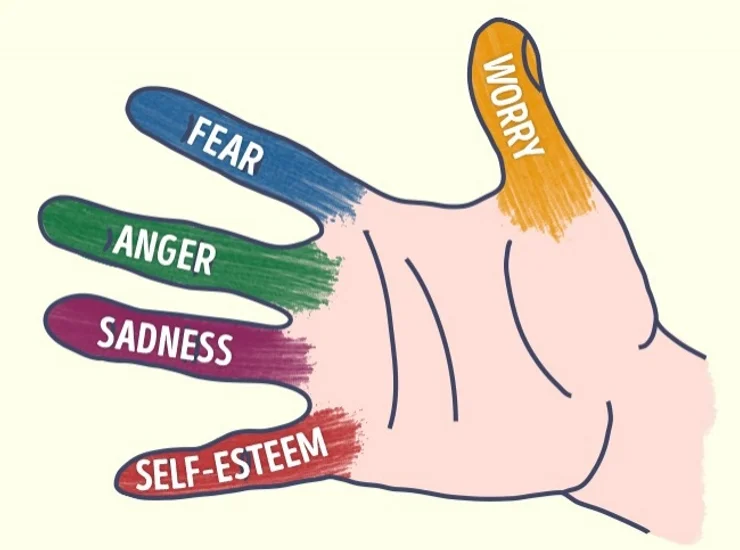[VIDEO] Pressure Points On Hands To Relieve Stress

Stress has unfortunately invaded every piece of our life nowadays. No matter if its meeting expectations, deadlines or some kind of argument with your partner, stress affects every one of us.
Some people can manage it while other suffer from chronic stress, but either way, it affects our health in a negative way and can cause numerous problems.
Chronic stress, for example, attacks our whole body at a cellular level and has been linked to serious diseases. [1]
If you’re often under too much stress, you’re putting your health in serious danger. Both mentally and physically, the effects of stress can be devastating. This is why we all need to learn how to deal with stress naturally and reduce the risk of various diseases and conditions.
This can be done in many ways. You can listen to your favorite tunes, try yoga or take up a hobby, take a long hot bath, drink a cup of tea or just hang out with your friends.
Anything that makes you happy can instantly relieve stress and make you feel better. Most people try to reduce stress with antidepressants and other types of pills, but they are just as dangerous as stress, not to mention ineffective in most cases.
Fortunately, there’s these ancient japanese pressure points on hands to relieve stress, that will be talking down this article.
The method doesn’t involve the use of any kind of medicine or even remedy. In fact, it’s based on applying pressure on certain points on the hand which relieve tension and stress when massaged.
What is Acupressure?
The method is known as acupressure and has been used to relieve all sorts of health problems for centuries.
Acupressure is a traditional Chinese healing technique that involves applying manual pressure to specific points on the body to promote relaxation, alleviate pain, and improve overall well-being.
Is origin is from ancient Chinese medicine and is based on the idea that vital energy, called “qi” (pronounced “chee”), flows through pathways known as meridians in our bodies.
The fundamental principle of acupressure is to balance and enhance the flow of qi through these meridians. When qi is blocked or disrupted, it can lead to various physical or emotional ailments. Acupressure aims to restore harmony and stimulate the body’s natural ability to heal itself.
Accupressure “moved” to other Asian countries – like Japan – who in their turn made slight variations to accupressure.

In ancient Japanese culture, stress can be dealt with through the hands. The Japanese believe that our fingers represent a certain emotion, and by addressing a particular finger we can relieve any kind of problem.
- The thumb is associated with anxiety and worrying;
- the index finger can be massaged to overcome fear;
- the middle finger corresponds to anger;
- the ring finger is linked to sadness and depression, and
- the pinky can be stimulated to boost self-esteem.
Pressure Points On Hands To Relieve Stress
Here’s a video that will show where other stress-relieving pressure points are:
How Does It Work?
Each of the fingers needs to be massaged for 1-2 minutes for the method to work. Open your hand wide and spread your fingers nicely.
- Start with the thumb – pinch the sides of the tip and apply firm pressure, then move down the finger with the same pressure. You need to press enough until you feel a pulse. When moving down the finger, stop for a few seconds on each segment and focus on the pulse. Continue doing this for a minute or two.
- Also, there’s a special pressure point between the index finger and thumb – it’s the muscle above the base of the thumb. It’s full of nerves that can be stimulated to relieve tension in the head and whole body. Just squeeze it with steady pressure and massage it a bit – you’ll feel much better in a few minutes.
- There’s another stress-relieving pressure point on the wrist, on the spot where the bones and arm meet. Massaging this spot with slight pressure should help you release negative thoughts and stop worrying. Don’t worry about the slight tingling – it’s completely normal. The indentation on the opposite side of the wrist can also be massaged to relieve stress and clear your mind.
Tips to make acupressure more effective
Try following these tips when you perform acupressure at home. They will help you achieve greater results.
- Focus on Breathing: Take slow, deep breaths during acupressure to relax your body and enhance the flow of energy. Deep breathing helps you stay calm and aids in the effectiveness of the pressure points you’re working on.
- Locate Pressure Points Accurately: Precise location is key. Use diagrams or guides to pinpoint the right spots. Pressing slightly off-target may not yield the desired results.
- Gradual Pressure Application: Apply pressure gradually. Start with a gentle touch and slowly increase it. Avoid sudden force, which could cause discomfort.
- Consistency Matters: Regularity is essential. Consistently stimulate your chosen pressure points for the best outcomes. Daily sessions often lead to more lasting relief.
- Mind Your Posture: Maintain good posture during acupressure. Sit or stand comfortably to ensure that you can concentrate on the pressure points without straining.
- Stay Relaxed: Relax your muscles and clear your mind. Tension can impede the energy flow. Find a quiet, peaceful space for your acupressure sessions.
- Use Your Fingertips: Your fingertips are ideal for applying pressure. Keep your nails trimmed to prevent discomfort or injury to the skin.
- Massage and Circular Motions: Instead of just pressing, try gentle circular motions on the pressure points. This can help stimulate the area more effectively.
- Be Patient: Results may not be immediate. Acupressure is a gradual process, and it might take several sessions before you notice significant improvements.
- Hydration and Rest: Drink enough water and get adequate rest. Hydration aids in energy circulation, while rest supports your body’s natural healing processes. These complement acupressure’s effectiveness.
Is acupressure the same as acupuncture?
No, acupressure is not the same as acupuncture, although they both involve stimulating specific points on the body to promote healing and wellness.
Here are the key differences between the two:
| Acupressure | Acupuncture | |
| Stimulation Method | Acupressure, on the other hand, involves applying manual pressure, usually with the fingertips, thumbs, or hands, to specific acupuncture points. There are no needles involved in acupressure. | In acupuncture, thin needles are inserted into specific acupuncture points on the body. These needles are typically left in place for a period of time and may be manipulated by the practitioner. |
| Tools Used | Acupressure is a non-invasive technique that does not require any tools other than the practitioner’s hands or fingers. | Acupuncture requires the use of specialized acupuncture needles, which are sterile and single-use. |
| Sensation | With acupressure, there is no insertion of needles, so patients typically feel pressure, but it is not associated with the same sensations as acupuncture. | Patients often report a sensation when the acupuncture needles are inserted, such as a dull ache, tingling, or warmth. This sensation is known as “qi” or energy flow. |
| Practitioner Training | Acupressure can be performed by various individuals, including massage therapists, physical therapists, and individuals trained in holistic or complementary therapies. It does not typically require the same level of formal certification as acupuncture. | Acupuncture is usually performed by trained and licensed acupuncturists who have undergone extensive education and certification in traditional Chinese medicine and acupuncture techniques. |
Both acupuncture and acupressure are based on the concept of meridians, which are energy pathways in the body. Both therapies aim to balance the flow of energy (qi) through these meridians to promote health.
While acupuncture and acupressure share a common foundation in traditional Chinese medicine and the stimulation of specific points on the body, they differ in the method of stimulation, tools used, and the level of training required for practitioners.
Frequently Asked Questions
Bottom Line
Acupressure is a holistic healing technique that utilizes the body’s own energy pathways to alleviate stress and promote relaxation. By applying gentle pressure to specific hand points, these pressure points on hands for relieving stress can effectively reduce tension, ease anxiety, and enhance overall well-being.
While it’s not a substitute for professional medical advice or treatment, acupressure’s simplicity and accessibility make it a valuable tool for stress relief and self-care, allowing individuals to take an active role in managing their stress levels naturally.
Read Next
